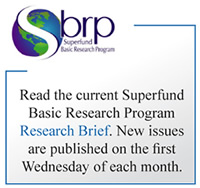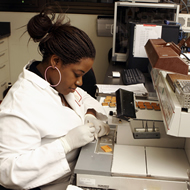
Environmental Factor, May 2009, National Institute of Environmental Health Sciences

Extramural Papers of the Month
By Jerry Phelps
May 2009
- Pesticide Exposure Raises Risk of Parkinson’s Disease
- Solution Found to Increase Nanotube Luminescence
- Nasal Injury in Rats Exposed to Diacetyl May Be Predictive of Lung Injury in Humans
- Increased Immunoglobulin in Children with Autism
Pesticide Exposure Raises Risk of Parkinson’s Disease
NIEHS-funded epidemiologists at the University of California Los Angeles found that exposure to the combination of the fungicide maneb and the herbicide paraquat increased the risk of later development of Parkinson’s disease. For people diagnosed with the degenerative disease prior to age 60, the risk was increased four- to six-fold.
The study reports that living within 500 meters of agricultural operations where the pesticides were sprayed increased residents’ risk by 75 percent. The exposures occurred between 1975 and 1999, and the timing of the exposure proved to be a critical factor in the study. For people who were diagnosed at early ages, the exposure occurred when they were children, teens or young adults. The study participants included 368 long-term Central Valley residents with Parkinson’s.
The research team developed a geographic information system approach for estimating exposure, based on California pesticide-use records. All addresses for the study participants were used to give an accurate estimate of their total exposure from 1974 through 1999, coinciding with the dates of the pesticide-use records.
According to the study’s senior author, Beate Ritz, the new study confirms previous observations in animal studies that exposure to multiple chemicals may increase the effects of each chemical and that the timing of the exposure is an important risk factor.
Citation: Costello S, Cockburn M, Bronstein J, Zhang X, Ritz B (http://www.ncbi.nlm.nih.gov/pubmed/19270050?ordinalpos=2&itool=EntrezSystem2.PEntrez.Pubmed.Pubmed_ResultsPanel.Pubmed_DefaultReportPanel.Pubmed_RVDocSum) ![]() . 2009. Parkinson's disease and residential exposure to maneb and paraquat from agricultural applications in the central valley of California. Am J Epidemiol 169(8):919-926. Epub 2009 Mar 6.
. 2009. Parkinson's disease and residential exposure to maneb and paraquat from agricultural applications in the central valley of California. Am J Epidemiol 169(8):919-926. Epub 2009 Mar 6.
Solution Found to Increase Nanotube Luminescence
Chemists at the University of Connecticut have found a way to increase the luminescence efficiency of single-walled carbon nanotubes, which could lead to better use of nanotechnology in medical imaging and other applications. Increasing the luminescence efficiency of carbon nanotubes could lead to their use in detecting tumors, arterial blockages and other internal problems that are now diagnosed with potentially harmful x-rays, radioactive dyes or more invasive methods. Physicians could scan patients with a device that would capture a very sharp image from the light given off by the carbon nanotubes.
Previous work in this and other laboratories had been able to raise the light emitted from nanotubes by only 0.5 percent. The new discovery is best described as a chemical sleeve wrapped tightly around the nanotube ,which reduces exterior defects. The chemical used is a derivative of vitamin B-12, also known as flavin. The flavin molecules "self-assemble" into a tube that adsorbs to the carbon nanotube.
The researchers claim that the act of self-assembly not only forms a new tubular structure, but that it actively cleans the surface of the underlying nanotube. The cleaned nanotubes achieve luminescence efficiency as high as 20 percent.
The researchers anticipate that a number of important applications may be possible as the result of their discoveries, including medical devices and biosensor applications.
Citation: Ju SY, Kopcha WP, Papadimitrakopoulos F (http://www.ncbi.nlm.nih.gov/pubmed/19265015?ordinalpos=3&itool=EntrezSystem2.PEntrez.Pubmed.Pubmed_ResultsPanel.Pubmed_DefaultReportPanel.Pubmed_RVDocSum) ![]() . 2009. Brightly fluorescent single-walled carbon nanotubes via an oxygen-excluding surfactant organization. Science 323(5919):1319-1323.
. 2009. Brightly fluorescent single-walled carbon nanotubes via an oxygen-excluding surfactant organization. Science 323(5919):1319-1323.
Nasal Injury in Rats Exposed to Diacetyl May Be Predictive of Lung Injury in Humans
Exposure to the butter flavor ingredients diacetyl and butyric acid has recently been found to cause a respiratory condition called bronchiolitis obliterans. The popular press has dubbed the condition "popcorn workers lung" because it is otherwise a rare condition, but strikes workers in the popcorn industry at a much higher rate than the general population. The condition causes scarring of the lungs that inhibits normal respiration.
NIEHS-supported scientists investigating the health effects of butyric acid and diacetyl have discovered that the severity of airway injuries in rats above the level of the lung are predictive of similar injuries in human lung tissue. The current results suggest that simultaneous exposure to butyric acid and diacetyl may increase the toxicity and potential lung injury caused by diacetyl.
Butyric acid is a potent inhibitor of an enzyme known as diacetyl reductase that metabolizes diacetyl. These findings highlight the need to consider the multiple components of butter flavoring vapors in comprehensive risk assessments and safety evaluations.
Citation: Morris JB, Hubbs AF (http://www.ncbi.nlm.nih.gov/pubmed/18940962?ordinalpos=3&itool=EntrezSystem2.PEntrez.Pubmed.Pubmed_ResultsPanel.Pubmed_DefaultReportPanel.Pubmed_RVDocSum) ![]() . 2009. Inhalation dosimetry of diacetyl and butyric acid, two components of butter flavoring vapors. Toxicol Sci 108(1):173-183.
. 2009. Inhalation dosimetry of diacetyl and butyric acid, two components of butter flavoring vapors. Toxicol Sci 108(1):173-183.
Increased Immunoglobulin in Children with Autism
New data on autism from NIEHS-supported grantees at the University of California, Davis presents additional information that immune dysfunction is associated with autism disorders. Previous reports have shown abnormal immunoglobulin levels, including increases in blood levels of auto-reactive antibodies in people with autism.
Since IgG is the predominant antibody isotype found in the blood, the researchers hypothesized that an altered immune response could result in an abnormal IgG profile in children with autism. They measured plasma levels of four different isotypes of IgG in 241 children from the Childhood Autism Risks from Genetics and the Environment study — a large epidemiologic case-control investigation. The study included 114 children with autism disorder, 96 typically developing control children and 31 children with developmental delays.
They found significantly increased levels of the IgG4 subclass in children with autism disorder as compared to the control children and the children with developmental delays. The results suggest an underlying immunological abnormality in children with autism disorder. The researchers conclude that additional investigation is necessary to determine the relationship between immunological findings and behavioral impairments in autism.
Citation: Enstrom A, Krakowiak P, Onore C, Pessah IN, Hertz-Picciotto I, Hansen RL, Van de Water JA, Ashwood P (http://www.ncbi.nlm.nih.gov/pubmed/19136055?ordinalpos=1&itool=EntrezSystem2.PEntrez.Pubmed.Pubmed_ResultsPanel.Pubmed_DefaultReportPanel.Pubmed_RVDocSum) ![]() . 2009. Increased IgG4 levels in children with autism disorder. Brain Behav Immun 23(3):389-395.
. 2009. Increased IgG4 levels in children with autism disorder. Brain Behav Immun 23(3):389-395.
(Jerry Phelps is a program analyst in the NIEHS Division of Extramural Research and Training. Each month, he contributes summaries of extramural papers to the Environmental Factor.)
"Extramural Update..." - previous story ![]()
![]() next story - "Intramural Papers of the Month..."
next story - "Intramural Papers of the Month..."
May 2009 Cover Page



